C3-V3.1: Ergebnishaus des C³-Projektes – CUBE
Inhaltsverzeichnis
Projektdaten
| Titel | Title TP C3-V3.1-I: Weiterentwicklung, Untersuchung und Nachweisführung von Bauteilen und Tragwerken aus Carbonbeton sowie wissenschaftliche Begleitung von Entwurfs-, Konstruktions- und Bauüberwachungsprozessen im Carbonbetonbau im Vorhaben C3-V3.1: Ergebnishaus des C³-Projektes – CUBE | SP C3-V3.1-I: Advanced development, investigation and feasibility analysis of building components and structures made of carbon reinforced concrete as well as scientific support for the design, engineering and supervision processes of carbon concrete constructions as part of the joint research project C3-V3.1: C³ technology demonstration house – CUBE Förderer | Funding Bundesministerium für Bildung und Forschung (BMBF) / C3 – Carbon Concrete Composite Zeitraum | Period 09/2017 – 09/2022 Verbundvorhabenleiter | Leader of the joint research project Prof. Dr.-Ing. Dr.-Ing. E.h. Manfred Curbach Leiter Teilvorhaben | Subproject manager Prof. Dr.-Ing. Dr.-Ing. E.h. Manfred Curbach Team | Team Dr.-Ing. Michael Frenzel, Iurii Vakaliuk M.Sc., Dipl.-Ing. Angela Schmidt, Dipl.-Wirtsch.-Ing. (FH) Matthias Tietze Projektpartner | Project partners Institut für Betonbau, HTWK Leipzig | Architekten Ingenieure Bautzen GmbH | ASSMANN Bauen + Planen AG, Dresden | Betonwerk Oschatz GmbH | Bendl Hoch- und Tiefbau GmbH & Co. KG, Sebnitz | texton e. V., Dresden |
Bericht aus dem Jahrbuch 2022
Carbonbetonhaus CUBE fertiggestellt
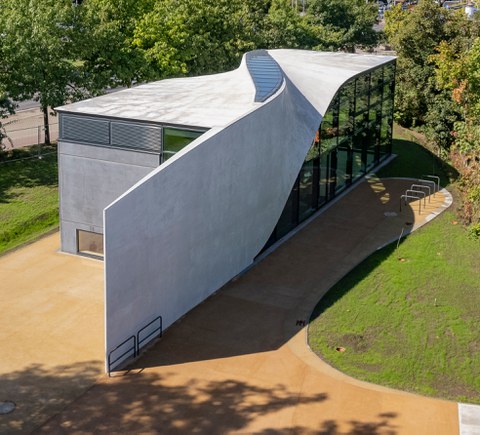
Luftbild des fertigen CUBE
Anfang 2022 konnten die TWIST-Elemente und die anschließenden Flügel und damit die Bauwerkshülle des CUBE komplettiert werden. Besonders anspruchsvoll war die 32 m lange, bis zu 7 m breite und lediglich 4 cm dicke, fugenlos durchlaufende Wetterschale, die die Ansicht des CUBE dominiert. Am 3. Februar 2022 war der Rohbau fertiggestellt, was mit einem Richtfest gefeiert wurde.
Nachdem die temporäre Gebäudeumhausung demontiert war, begannen die weiteren Ausbaugewerke mit ihrer Arbeit. Ab Februar wurden die Trockenbauwände, eine Teekücheneinheit aus Carbonbetonfertigteilplatten sowie die Leitungen und die Geräte der Heizungs-, Lüftungs- und Sanitäranlage eingebaut. Parallel dazu platzierten die Elektriker Kabel und Leerrohre, später auch Steckdosen und Lampen. Im Bereich der Fassade wurden die bis zu 2,6 m × 2,7 m großen Glasscheiben und die vier Hauseingangstüren eingebaut.
Ab April fanden umfangreiche Arbeiten im Außenbereich statt. Für die Verkehrsflächen mussten Altboden ausgetauscht und tragfähiges Untergrundmaterial eingebaut werden. Nach dem Einbau der Frostschutzschicht wurde schließlich ein spezieller Drainbeton aufgebracht, der als Einkorngemisch derart porig ist, dass das Regenwasser hindurchfließen kann. Im Juli war der Estrich ausreichend getrocknet, sodass sowohl das Stabparkett im Hauptraum als auch das dunkelblaue Linoleum in den Sanitär- und kleineren Büroräumen verlegt werden konnten. Eine besondere Herausforderung stellte die Montage des Dachlichtbandes dar, das zwischen den beiden TWIST-Elementen angeordnet ist und zusätzliches Licht in den Hauptraum bringt. Schließlich war das Lichtband mit ebenen Glasscheiben und mit linienförmigen, geraden Trägerprofilen auf die räumlich geschwungenen TWIST-Randbalken millimetergenau zu befestigen. Ein besonderes Augenmerk war zudem auf die Anschlüsse zu richten, damit diese wasserdicht und gut wärmegedämmt sind. Die Arbeiten konnten im September beendet werden, sodass der Eröffnung des Gebäudes am 28.09.2022 im Rahmen der 14. Textil- und Carbonbetontage nichts mehr im Wege stand.
Bericht aus dem Jahrbuch 2021
Carbonbetonhaus CUBE – im Bau
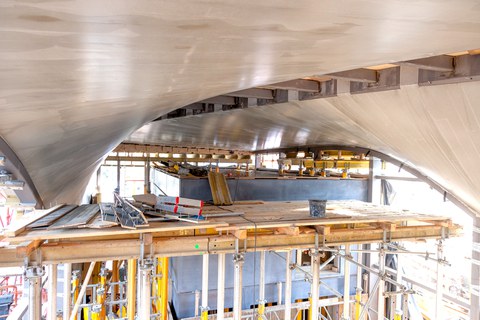
TWIST-Schale im Bauzustand
Zur weiteren Umsetzung des Carbonbetonhauses CUBE am Campus der TU Dresden, konnte im Dezember 2020 das Vergabeverfahren abgeschlossen und die Beauftragung der Roh- und Ausbauleistungen erteilt werden. Die Arbeiten übernahmen als Arbeitsgemeinschaft (Arge) die Bauunternehmen Bendl HTS, Sebnitz und Hentschke Bau, Bautzen. Die Gewerke Heizung, Lüftung, Sanitär, Gebäudeautomation, Elektrik und Geothermie wurden separat im Winter 2020/21 an die Elektro-Poick GmbH, Cölln, die R & Z Innovative Haustechnik GmbH, Radibor und BauGrund Süd Gesellschaft für Geothermie mbH, Bad Wurzach vergeben. Da bereits 2020 die Baugrube erstellt wurde, konnte die Arge im Januar 2021 mit den Gründungsarbeiten beginnen.
Bis zum Mai 2021 errichtete Bendl HTS den zweigeschossigen CUBE-Fertigteilkomplex „BOX“. Die Halbfertigteilwände, Decken und Treppen stellte das Betonwerk Oschatz her. Die Wände bestehen innen und außen aus lediglich 4 cm dünnen, Carbonbetonschalen zwischen die eine 7 cm starke Hochleistungsdämmung und ein 12 cm dicker Füllbeton eingebracht wurden, sodass sich eine schlanke Außenwand mit einer Gesamtstärke von 27 cm ergibt. Die Decken sind 25 cm stark, ca. 4,7 m lang und einachsig gespannt. Sie weisen einen Hohlkörperquerschnitt auf, um den Betonverbrauch möglichst gering zu halten. Die Hohlkörper wurden in der Art eingebracht, dass ein Deckenelement aus nur 3 cm dicken, carbonbewehrten Gurten und 19 cm hohen, 6 cm breiten Stegen besteht. Zur Verbindung der Fertigteile kamen Ortbeton und nichtmetallische Stab- und Bügelbewehrung zum Einsatz.
Im Juni montierte die Metallbau Schubert GmbH die Stahlstützen und -riegel, die sowohl einen Teil der Fassade bilden als auch zur Auflagerung der beiden verdrehten Dach-Wandschalen („TWIST“-Elemente) dienen. Nach dem Schalungsaufbau konnte schließlich im August die Herstellung der beiden Flügel und im Oktober der „TWIST“-Elemente beginnen. Diese bestehen aus einer 25 cm starken Tragschicht mit leichten Füllkörpern, einer 15 cm dicken Dicht- und Dämmschicht und einer 4 cm dünnen Betonwetterschutzschicht. Die Arbeiten erfolgten von innen nach außen, schicht- und lagenweise. Dabei kamen zwei Spezialspritzbetone und Carbongelege zum Einsatz. Bis auf die Wetterschale konnten die beiden Flügel und „TWIST“-Elemente bis Ende 2021 vollständig hergestellt werden.
Bericht aus dem Jahrbuch 2019
Carbonbetonhaus CUBE – Bauantrag eingereicht!
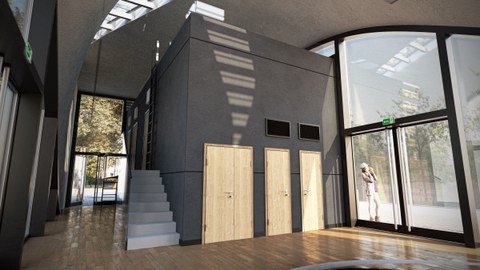
Blick aus dem Gebäudeinneren auf die Fertigteil-BOX
Auf Grundlage des im vergangenen Jahr fertiggestellten Gebäudeentwurfes erfolgte im ersten Halbjahr 2019 die weitere konstruktive Durchbildung des Carbonbetonhauses einschließlich statischer Berechnungen und geometrischer Anpassungen. Das Gebäude weist nun mit den seitlich auskragenden Flügeln eine Gesamtlänge von ca. 40,0 m, eine Breite von 7,2 m und eine maximale Höhe von etwa 6,9 m auf. Damit der CUBE an der Ecke Einsteinstraße/Zellescher Weg in Dresden gut positioniert und sichtbar ist, stellt der Eigentümer des Gebäudes, der Staatsbetrieb Sächsisches Immobilien- und Baumanagement, das gesamte 1650 m² große Flurstück zur Verfügung. Nach Abschluss der Entwurfsplanung im Sommer wurden alle Unterlagen für den Bauantrag fertiggestellt und im Oktober beim Dresdener Bauaufsichtsamt eingereicht .
Parallel konzentrierten sich die Arbeiten 2019 auf Herstellbarkeit der Carbonbetonbauteile. Der von außen dunkel gefärbte Gebäudebereich BOX besteht aus Halbfertigteildoppelwänden und Fertigteil(hohl)decken. Im Vorfeld wurden fünf BOX-Doppelwände und ein Deckenelement im Maßstab 1:1 zu einem fertigen Demonstratorbau zusammengefügt. Bei den ausführenden Arbeiten waren die Projektpartner Betonwerk Oschatz, auf dessen Gelände der Bau steht, und bendl HTS Hoch- und Tiefbau maßgeblich beteiligt. Mit Hilfe von Technologietests ließen sich die Abläufe bei der Planung und Ausführung, die Material- und Zeitaufwendungen, Kosten und erzielbaren Qualitäten bestimmen und eindeutig festlegen.
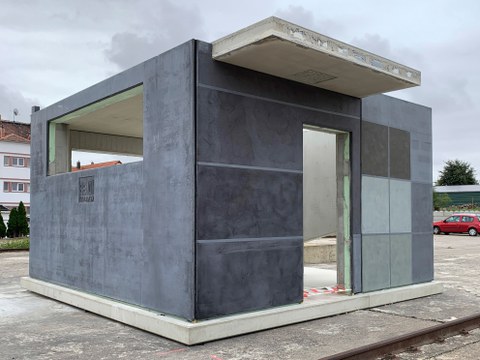
Ergebnis des Technologietests – BOX-Demonstrator
Zudem wurde der Aufbau des weiß erscheinenden, gekrümmten TWIST-Daches anhand von statischen und bauphysikalischen Berechnungen festgelegt. Es besteht aus einer schlanken, hohlkammerähnlichen, carbonbewehrten Tragschale mit lediglich 30 mm starken Deckschichten, 60 mm breiten Stegen, einer Wärmedämmebene sowie einer nur 40 mm dicken Carbonbeton-Sichtwetterschale. Die technische und technologische Umsetzbarkeit wurden baupraktisch herausgearbeitet und überprüft. Dazu fertigten die Projektpartner mit dem Betonspritzteam der Pagel Spezial-Beton Probekörper an, testeten verschiedene Betonmischungen, Abdichtungs- und Dämmmaterialien und deren Zusammenwirken. Die CUBE-Arbeiten waren im Dezember 2019 so weit vorangeschritten, dass die Ausführungsplanung beginnen und der Bauantrag eingereicht werden konnten.
Bericht aus dem Jahrbuch 2018
Carbonbetonhaus CUBE – Entwurf fertig!
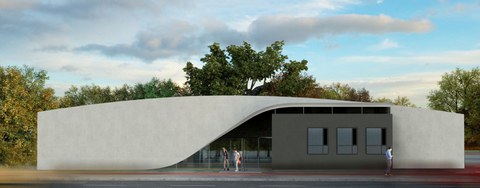
Entwurf des Ergebnishauses – CUBE
Bereits im Herbst 2017 fertigten Bauingenieur- und Architekturstudenten der HTWK Leipzig, FH Aachen und der Università di Camerino, Ascoli, Italien verschiedene Basisentwürfe für das Carbonbetongebäude CUBE im Rahmen des International Design AAL-Workshops an der HTWK Leipzig an. Sie dienten als Anregung und Vorarbeit für das CUBE-Team und das Berliner Architekturbüro HENN, die den Auftrag für die Vorentwurfsplanung erhielten. Im Februar 2018 lagen vier konzeptionelle Entwürfe vor, die als „Haus im Haus“, „Roof“, „Hypar“ und „Twist“ tituliert wurden. Der Vorentwurf „Twist“ erfüllt dabei die gesetzten Randbedingungen am besten, wobei hier der Schwerpunkt besonders auf die Signalwirkung des Gebäudes gelegt wurde.
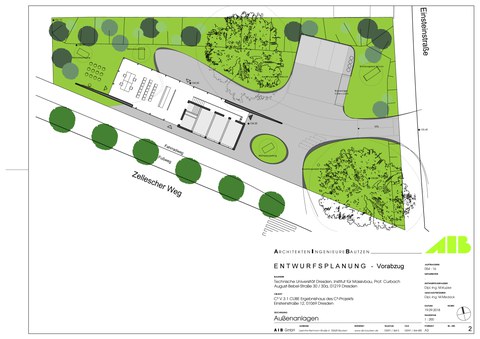
Lageplan des Ergebnishauses CUBE auf dem Grundstück am Zelleschen Weg
Im Sommer 2018 erfolgte eine genauere Aufarbeitung des Vorentwurfs hin zu einem Gebäude- und Objektentwurf, der alle Anforderungen hinsichtlich der gewünschten Funktionalität, dem C³-Ergebnispräsentationpotential und der sächsischen Bauordnung erfüllt. Das Gebäude weist eine Grundfläche von ca. 24,1 × 7,2 m (174 m²) und eine Bruttogeschossfläche von 220 m² auf. Die Längsseiten des Gebäudes sind nach Südwesten und Nordosten entlang des Zelleschen Weges ausgerichtet. Der Zugang zum Gebäude erfolgt östlich über die Einsteinstraße. Das Haus, das als Demonstratorbau und Versuchsstand konzipiert ist, besteht aus einem ebenerdigen Präsentationsraum mit einer Größe von ca. 90 m² und einem zweietagigen Technik- und Labortrakt mit sanitären Einrichtungen, der eine Fläche von ca. 100 m² einnimmt. Die untere Etage, die 1,6 m unterhalb des Geländes liegt, beherbergt die Gebäudetechnik und Versuchsstände für kleinformatige Carbonbetonbauteile. Das obere Geschoss besteht aus drei, 11 m² großen Laborräumen, in denen nach Bauende bauklimatische und tragsicherheitsrelevante Messungen durchgeführt werden können. Die Laborräume weisen jeweils eine große Fassadenöffnung auf, die mit Photovoltaik- und Fensterelementen flexibel bestückt werden kann.
Der Labortrakt und der Präsentationsraum werden durch zwei etwa 30 m lange, verdrehte Wand-Dachelemente (Twist-Elemente) überdeckt, deren Breite bzw. Höhe zwischen 4,0 m und 7,2 m variiert. Die beiden Elemente stützen sich gegenseitig ab und sind geometrisch als Regelfläche in der Art gewählt, dass sie ein Lichtband entlang des Firstverlaufes erzeugen. Unter den Twist-Elementen bildet eine Glasfassade den Raumabschluss. Im Winter 2018/19 wird das Gebäude im Detail durchgeplant.
Bericht aus dem Jahrbuch 2017
Carbonbetonhaus CUBE – gestartet
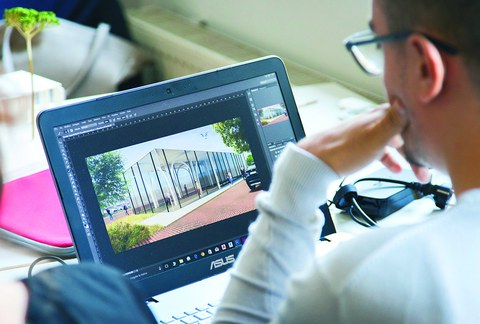
Entwurf eines Carbonbetongebäudes
Am 1.9.2017 fand das Auftakttreffen zu dem größten Teilvorhaben des Projektes C3 – Carbon Concrete Composite mit dem Titel „Ergebnishaus des C3-Projektes – CUBE“ statt. Über einen Zeitraum von mehr als anderthalb Jahren wurden zuvor Projektskizzen und -anträge ausgearbeitet, Gespräche mit Firmen und Partnern geführt, ein Finanzierungskonzept erstellt und vor allem – ein Baugrundstück organisiert. Für einen Zeitraum von zunächst 10 Jahren stellt der Staatsbetrieb Sächsisches Immobilien- und Baumanagement Dresden das Grundstück Einsteinstraße 12 in Dresden, das direkt am Fritz-Förster-Platz gelegen ist, mit einer Fläche von ca. 1300 m² zur Verfügung und übernimmt als Eigentümer die Arbeiten zum Baugrund und der öffentlichen und nicht-öffentlichen Medienerschließung sowie die Betreibung des Gebäudes.
Ziel ist es zu zeigen und am realen Objekt zu demonstrieren, dass Carbonbeton nutzbar und praxistauglich ist! Es wird die gesamte Prozesskette der Herstellung mit Planung, Berechnung, dem Erwerb von Zulassungen, der Kalkulation, der Vergabe, der Überwachung, Errichtung und Nutzung dargestellt und durchlaufen. Dabei kommt Carbonbeton als Baumaterial, als schützende Raumhülle und als Werkstoff für Gegenstände des Ausbaus zum Einsatz. Das Gebäude dient maßgeblich als Demonstrationsbau, Forschungsstätte sowie als Labor zur Untersuchung der Dauerhaftigkeit, Tragfähigkeit, Gebrauchstauglichkeit und bauphysikalischer Eigenschaften des Verbundmaterials Carbonbeton. Dazu werden entsprechende Räumlichkeiten zum Arbeiten und zum Analysieren, Messen und Präsentieren der (neusten) Forschungsergebnisse vorgesehen.
Die Leitung und die Dezernate der TU Dresden sowie das Institut für Massivbau übernehmen die Aufgaben des Bauherrn. Das Projekt wird zudem intensiv durch die HTWK Leipzig, Institut für Betonbau, die Büros AIB GmbH (Bautzen) und ASSMANN Bauen + Planen (Dresden) in den Bereichen Architektur, Bauphysik, Objekt-, Tragwerksplanung und Bauüberwachung bearbeitet und durch das Büro HENN (Berlin) und den texton e. V (Dresden) unterstützt. Den Fertigteilbau übernimmt das Betonwerk Oschatz und die Vororterrichtung und -montage führt die Bendl-HTS GmbH (Sebnitz) aus. Die Jahre 2017/18 dienen der planerischen Vorbereitung und der Erlangung von Genehmigungen, damit das Gebäude 2019/20 errichtet werden kann. Bis zum geplanten Projektende am 30.4.2021 sollen zudem erste Ergebnisse aus den Untersuchungen zur Gebrauchstauglichkeit, Dauerhaftigkeit und Bauphysik vorliegen.
